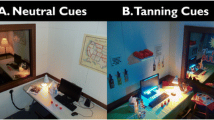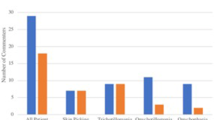Tanning in body dysmorphic disorder (BDD) has not previously been studied. In this study, 200 subjects with BDD were evaluated with measures to examine the prevalence of BDD-related tanning—i.e., darkening one's skin color by direct exposure to sunlight or artificial light which is motivated by a desire to improve a perceived appearance defect (i.e., a BDD concern). We also examined clinical characteristics of individuals who engaged in BDD-related tanning. 25% (95% CI, 19.0%–31.0%) of subjects reported BDD-related tanning. Among tanners, the skin was the most common body area of concern (84.0%). All tanners experienced functional impairment due to BDD, 26% had attempted suicide, and quality of life was markedly poor. 52% of tanners had received dermatologic treatment, which was usually ineffective for BDD symptoms. Tanners were more likely than non-tanners to compulsively pick their skin. In conclusion, tanning—a behavior with well-known health risks—is a relatively frequent BDD-related behavior.
Similar content being viewed by others
REFERENCES
Phillips KA: Body dysmorphic disorder. In Phillips KA (ed.) Somatoform and Factitious Disorders (Review of Psychiatry Series, Volume 20, Number 3; Oldham JM and Riba MB, series editors). Washington, DC., American Psychiatric Publishing, 2001.
Phillips KA: The Broken Mirror: Understanding and Treating Body Dysmorphic Disorder. New York, Oxford University Press, 1996 (Revised and Expanded Edition, 2005).
Hollander E, Cohen LJ, Simeon D: Body dysmorphic disorder. Psychiatric Annals 23:359–364, 1993.
Veale D, Boocock A, Gournay K, et al: Body dysmorphic disorder: a survey of fifty cases. British Journal of Psychiatry 169:196–201, 1996.
Phillips KA, McElroy SL, Keck PE Jr, et al: Body dysmorphic disorder: 30 cases of imagined ugliness. American Journal of Psychiatry 150:302–308, 1993.
Phillips KA, Grant J, Siniscalchi J, et al: Surgical and nonpsychiatric medical treatment of patients with body dysmorphic disorder. Psychosomatics 42:504–510, 2001.
Phillips KA, Hollander E, Rasmussen SA, et al: A severity rating scale for body dysmorphic disorder: development, reliability, and validity of a modified version of the Yale-Brown Obsessive Compulsive Scale. Psychopharmacology Bulletin 33:17–22, 1997.
Leon AC, Solomon DA, Mueller TI, et al: The Range of Impaired Functioning Tool (LIFE-RIFT): A brief measure of functional impairment. Psychological Medicine 29:869–878, 1999.
Ware JE Jr: SF-36 Health Survey Manual and Interpretation Guide. Boston, The Health Institute, New England Medical Center, 1993.
First Mb, Spitzer RL, Gibbon M, et al: Struetured Clinical Interview for DSM-IV Axis I Disorders Non-patient Edition (SCID-I/NP). New York, Biometrics Research, New York State Psychiatry Institute, 1996.
National Institute of Mental Health: Special feature: rating scales and assessment instruments for use in pediatric psychopharmacology research. Psychopharmacology Bulletin 21:714–1124, 1985.
Lim HW, Cooper K: The health impact of solar radiation and prevention strategies. Journal of the American Academy of Dermatology 41:81–99, 1999.
Habif TP: Clinical Dermatology, Fourth Edition: A Color Guide to Diagnosis and Therapy. Philadelphia, Mosby, 2004.
Gupta MA, Gupta AK, Haberman HF: Neurotic excoriations: a review and some new perspectives. Comprehensive Psychiatry 27:381–386, 1986.
Phillips KA, Taub SL: Skin picking as a symptom of body dysmorphic disorder. Psychopharmacology Bulletin 31:279–288, 1995.
O’Sullivan RL, Phillips KA, Keuthen NJ, et al: Near-fatal skin picking from delusional body dysmorphic disorder responsive to fluvoxamine. Psychosomatics 40:79–81, 1999.
Phillips KA, Diaz S: Gender differences in body dysmorphic disorder. Journal of Nervous and Mental Disease 185:570–577, 1997.
Phillips KA: Quality of life for patients with body dysmorphic disorder. Journal of Nervous and Mental Disease 188:170–175, 2000.
Cotterill JA: Body dysmorphic disorder. Dermatology Clinics 14:457–463, 1996.
ACKNOWLEDGMENTS
This study was supported by a grant from the National Institute of Mental Health (R01 MH60241) to Dr. Phillips.
Author information
Authors and Affiliations
Corresponding author
Rights and permissions
About this article
Cite this article
Phillips, K.A., Conroy, M., Dufresne, R.G. et al. Tanning in Body Dysmorphic Disorder. Psychiatr Q 77, 129–138 (2006). https://doi.org/10.1007/s11126-006-9002-2
Published:
Issue Date:
DOI: https://doi.org/10.1007/s11126-006-9002-2




